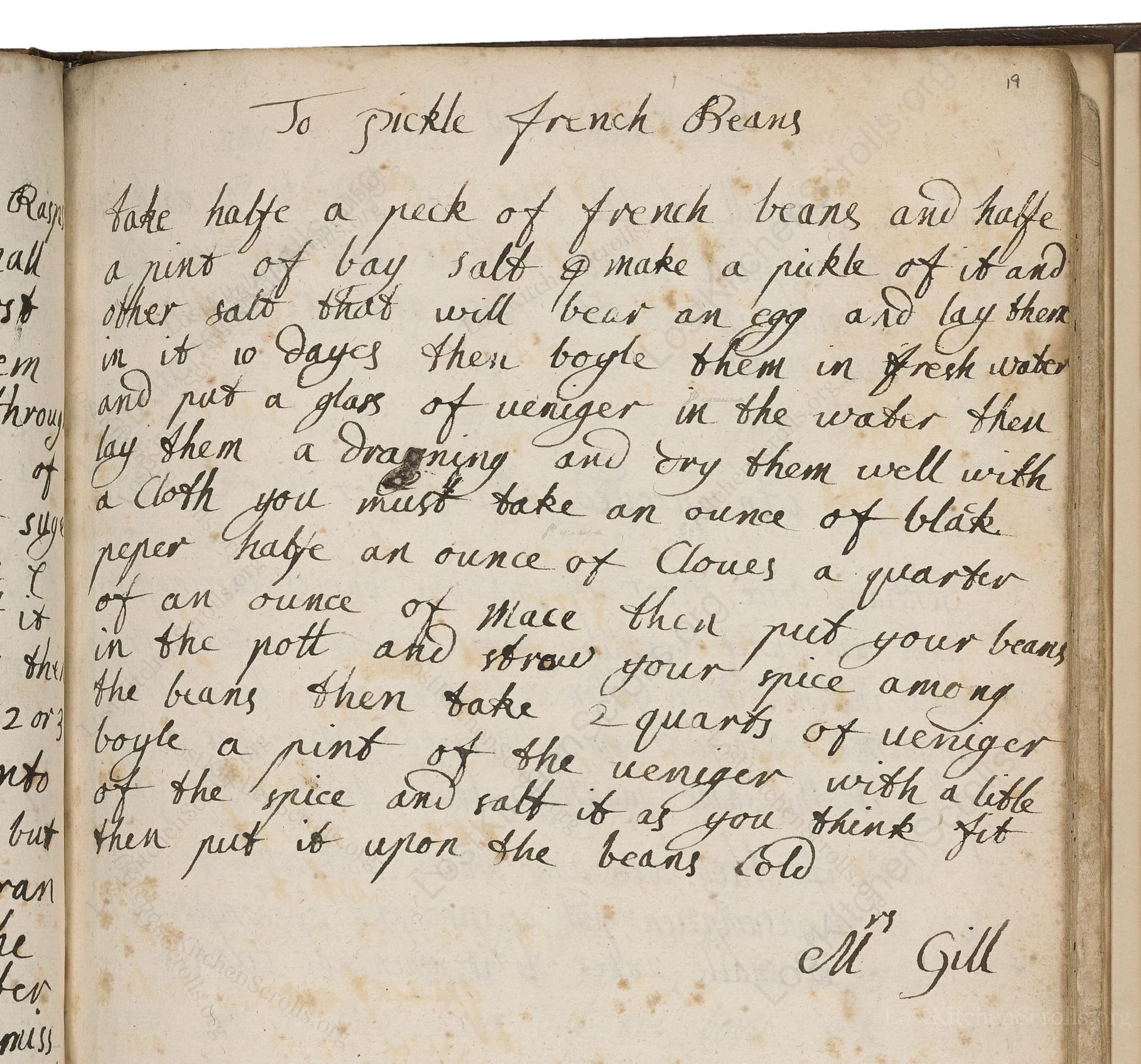To Pickle French Beans
From the treasured pages of Receipt book
Unknown Author

To Pickle French Beans
"take halfe a peck of french beans and halfe a pint of bay salt & make a pickle of it and other salt that will bear an egg and lay them in it 10 dayes then boyle them in fresh water and put a glass of veniger in the water then lay them a drayning and dry them well with a cloth you must take an ounce of black peper halfe an ounce of cloves a quarter of an ounce of mace then put your beans in the pott and strow your spice among the beans then take 2 quarts of veniger boyle a pint of the veniger with a litle of the spice and salt it as you think fit then put it upon the beans cold Mrs Gill"
Note on the Original Text
This recipe is written in a typically abbreviated, almost telegraphic form, assuming the reader already has experience with basic techniques like brining, draining, and using spices. The spelling is characteristic of the late 17th and early 18th centuries—'boyle' for 'boil', 'veniger' for 'vinegar', and instructions to 'strow' (strew) the spice among the beans. Quantities are a mix of volume and weight, and units like 'peck' have been converted to modern metric values.

Title
Receipt book (1700)
You can also click the book image above to peruse the original tome
Writer
Unknown
Era
1700
Publisher
Unknown
Background
A delightful glimpse into the kitchens of the early 18th century, this historic culinary manuscript promises a feast of recipes, remedies, and perhaps a pinch of mystery. Expect both practical fare and elegant inspiration for the curious cook.
Kindly made available by
Folger Shakespeare Library
This recipe comes from an English manuscript dated around 1700, a period when pickling was a primary method for preserving seasonal produce for the winter months. French beans, or haricots verts, were considered a luxury in England at the time, and this method ensured they could be enjoyed long after the growing season. The recipe demonstrates both household ingenuity and the importance of spice in upper-middle-class kitchens, as spices like mace and cloves were still valuable imports.

In the early 18th century, cooks would have used large earthenware or stoneware pots for soaking and pickling. Other essential tools included heavy kitchen knives, linen cloths for drying, wooden spoons for stirring, brass or copper pans for boiling, and glass or glazed pottery jars for the finished pickles. All work was done by hand, with no refrigeration, using only cool pantries or cellars for storage.
Prep Time
30 mins
Cook Time
30 mins
Servings
20
We've done our best to adapt this historical recipe for modern kitchens, but some details may still need refinement. We warmly welcome feedback from fellow cooks and culinary historians — your insights support the entire community!
Ingredients
- 4 quarts (approx. 4 1/2 lbs) French beans (haricots verts), trimmed
- 1 1/4 cups bay salt (or 1 1/4 cups flaky sea salt + 3 dried bay leaves, crushed)
- Regular salt, as needed for brine (to test, an egg will float)
- Water, enough to cover beans
- 1/4 cup vinegar (for boiling water stage)
- 1 oz whole black peppercorns
- 1/2 oz whole cloves
- 1/4 oz whole mace blades
- 2 quarts vinegar (for pickling—apple cider or wine vinegar is a good substitute)
- Additional salt, to taste
Instructions
- Begin with about 4 quarts of French beans (haricots verts), trimmed.
- Dissolve 1 1/4 cups of bay salt (or a mixture of flaky sea salt and crushed bay leaves) and sufficient regular salt in water so that an egg will float—this indicates brine saturation.
- Soak the beans in this pickle for 10 days.
- Next, boil the beans briefly (about 2-3 minutes) in fresh water to which a small glass (about 1/4 cup) of vinegar has been added.
- Drain the beans and dry them thoroughly with a clean cloth.
- Layer the beans in a jar, scattering over 1 ounce of black peppercorns, 1/2 ounce of whole cloves, and 1/4 ounce of mace broken into pieces.
- Boil 2 quarts of vinegar with a little of the reserved spice mix and salt to taste; cool this mixture.
- Pour the cooled, spiced vinegar over the beans and spices in the jar, ensuring everything is well-submerged.
- Seal and leave to pickle for several weeks before enjoying.
Estimated Calories
35 per serving
Cooking Estimates
This recipe takes some patience! You'll spend about 30 minutes preparing the beans and brine on day one. After soaking for 10 days, the actual cooking – boiling and pickling – shouldn’t take more than 30 minutes hands-on time. The calorie estimate assumes pickled French beans without added sugar, at a typical serving size.
As noted above, we have made our best effort to translate and adapt this historical recipe for modern kitchens, taking into account ingredients nowadays, cooking techniques, measurements, and so on. However, historical recipes often contain assumptions that require interpretation.
We'd love for anyone to help improve these adaptations. Community contributions are highly welcome. If you have suggestions, corrections, or cooking tips based on your experience with this recipe, please share them below.
Join the Discussion
Rate This Recipe
Dietary Preference
Main Ingredients

Den Bockfisch In Einer Fleisch Suppen Zu Kochen
This recipe hails from a German manuscript cookbook compiled in 1696, a time whe...

Die Grieß Nudlen Zumachen
This recipe comes from a rather mysterious manuscript cookbook, penned anonymous...

Ein Boudain
This recipe comes from an anonymous German-language manuscript cookbook from 169...

Ein Gesaltzen Citroni
This recipe, dating from 1696, comes from an extensive anonymous German cookbook...
Browse our complete collection of time-honored recipes



